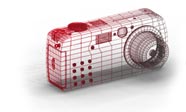 |
|
||
|
|
|
Main / Photography GlossaryA | B | C | D | E | F | G | H | I | J | K | L | M | N | O | P | Q | R | S | T | U | V | W | X | Y | Z Macro Lens A lens that provides continuous focusing from infinity to extreme close-ups, often to a reproduction ratio of 1:2 (half life-size) or 1:1 (life-size). Nikon's version for their "macro" is "micro", eg. 105mm F2.8 Micro-Nikkor. Micro lens A lens for close-up photography; designed to focus continuously from infinity down to a reproduction ratio of 1: 2, or with a matched extension ring or teleconverter down to 1: 1; available in normal or telephoto focal lengths to provide a variety of free working distances; with the exception of Nikon, this type of lens is called a "Micro Nikkor" lens. Also see above, Macro or Makro (Usually for German origin lenses).. Macro photography The process of taking photographs of small objects with regular photographic lenses at reproduction ratios of 1X or greater; also referred to as "photomacrography. " Magazine A lighttight metal container (cartridge) that holds 135 film (cylindrical magazine) or when apply to medium format, magazine back refer to the inter changeable container that holds the films for mounting on the back of the camera for exposures. Magicube. Special form of flashtube which is fired by mechanical (not electrical) means. Can be used only on cameras fitted with the appropriate socket. Magnification ratio Ratio that express greatest possible on film magnifying power of the lens. Used commonly on the macro setting of the zoom lenses, macro lens or with bellows. Manual: User selects both shutter speed and aperture, following or ignoring the meter's recommendations to achieve the desired exposure. Manual flash : Flash output is controlled manually in manual flash mode unlike in auto flash mode, where flash output power varies automatically according to the selected aperture. Some Speedlights, example like the Nikon SB 27, SB 26, SB-25. SB-24 and SB 20, provide selectable manual outputs (full, 1/2, l/4, 1/8, l/16 etc.), while others provide full manual output only. Manual iris. Diaphragm controlled directly by a calibrated ring on the lens barrel. Matrix Metering system : An exposure metering system using a multi-segment sensor and computer. Available in some Nikon SLRs.With the classic techniques of evaluating for 18% reflectance, factors such as brightness and contrast are primarily used to determine exposure. In addition, it is essential to evaluate each scene's esthetic factors such as color to get the best exposure. Check Nikon's own terms. Mammum aperture The widest aperture which the diaphragm is capable of opening up to; it is engraved on the lens in this manner; 1: 1.4. Microprism. Minute glass or plastic structure of multiple prisms set in a viewfinder screen to act as a focusing aid. Breaks up an out-of-focus subject into a shimmer but images a focused subject clearly. Will not work satisfactorily at lens apertures smaller than f5.6. Mid-roll change Feature available on the some APS camera that enables users to remove a partially exposed film cassette, insert it again later, and start shooting exactly where they left off. Mini-lab Also 1 hour colour lab. Photofinishing operation that operates on a retail level, serving consumers directly and processing film on-site. Mirror lens (Reflex Lens). Lens in which some (usually two) of the elements are curved mirrors. This construction produces comparatively lightweight short fat long focus lenses. They cannot be fitted with a normal diaphragm. MTF Modulation Transfer Function. The way people (who else, the magazines!) uses to measure a lens's ability to hold diminishing details of a subject. Why MTF ? Because, everything is done electronically and eliminating any errors in human judgement or vision and results can be repeatable to counter check earlier tests. Secondly, a precise comprehensive rating is made possible by incorporating huge amount of data into a single reading, lastly it is very fast and permit its use on just out from production lenses. Modelling. Representation by lighting of the three-dimensional nature of an original in a two-dimensional reproduction. Monitor Pre-flash(es): When performing Automatic Balanced Fill-Flash with TTL Multi Sensor, the Speedlight fires a series of scarcely visible pre-flashes to enable the camera's computer to pre-analyze the scene. The TTL Multi Sensor ins de the camera body reads the amount of reflected light, then the camera's microcomputer determines the area of the TTL sensor to be used for flash output control and adjusts the flash output level. The Monitor Pre-flashes are visible but not recognizable. First adopted by Contax RTS III, now Nikon is using this for its top flagship model, the F5. Motor Drive A mechanism for advancing the film to the next frame and recocking the shutter, activated by an electric motor usually powered by batteries. Popular for action-sequence photography and for recording images by remote control. Multilayer coating The depositing of multiple coats of anti-reflective materials on a lens surface to reduce ghost images and flare produced by internal reflections and insure faithful color rendition; in the Nikon Integrated Coating system, the number of layers is determined by the type of optical glass and the position of the element in the lens design. |
| © Copyright 2024 ShutterMag.com All Rights Reserved. |
